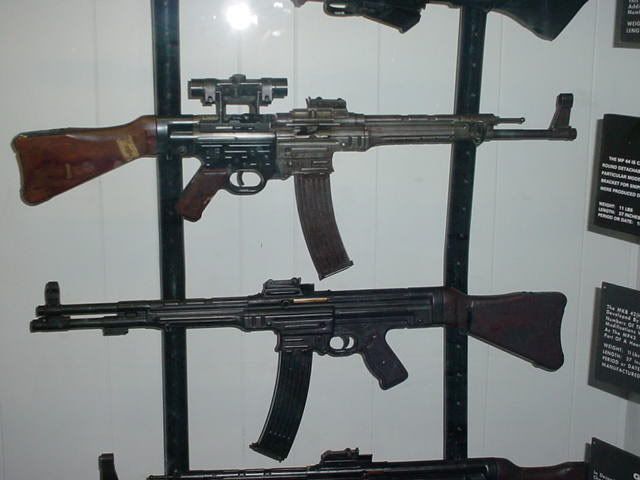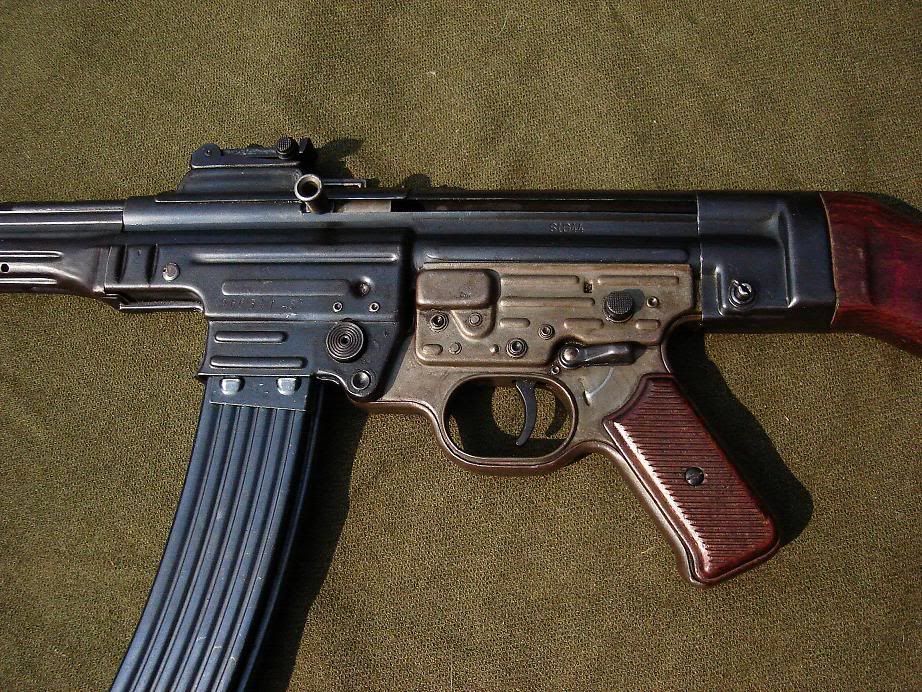
Be that as it may,but Romanian troops grew to love it.Most of these submachine guns were delivered to the troops deployed to the Eastern front,so most of them were lost in the vast space of the Russian steppes.

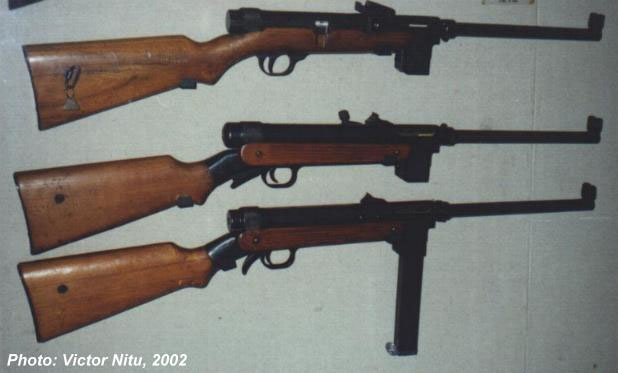
Photo A1: Orita SMGs in the National Military Museum in Bucharest
By the end of World War I it was very clear that plenty of automatic firepower was needed by the mobile warfare. New tactics had been developed. A new type of military weapon was the solution, something between a pistol and a rifle. It had to be a hand-held light automatic-magazine-fed weapon for short-range combat, firing a pistol cartridge. The air-cooled barrel also had to be short and the great firepower new weapon with a simple mechanism was necessary to be fired from the hip or the shoulder. This is how the submachine gun (SMG) was born, a portable weapon for hit and run tactics capable of spraying the enemy with a deadly rain of bullets. First Italy and Germany developed during World War I the SMG, mostly as an infantry weapon. This new type of military weapon was to play a very important role in the future wars and conflicts.
By 1939 many countries and all the major armies had their own SMG designs and a large variety of these powerful weapons had been manufactured. In Great Britain the British army with the military authorities did not recognize the need for a SMG (or "machine carbine") which had been considered a "gangster weapon". The British arsenal had no SMGs but soon in the dark early days of World War II their gross mistake was clear and the fast need for SMGs became a reality. World War II was about to create a huge demand for SMGs.

Drawing 1: 9mm Orita SMG Silhouette (right side). The model seen here has a crossbolt safety in front of the trigger guard.
In south-eastern Europe on the Black Sea, Romania was well aware at the opening of the World War II of the importance of developing the armament industry. With prior help and assistance from some foreign countries, especially Czechoslovakia, the Romanian military forces were equipped with a large variety of small arms. An original Romanian design, the 9mm Orita Model 1941 SMG entered service in 1943. With a high quality in design and manufacture, Orita SMG was entirely made during World War II at the state arsenal at Cugir, an important industrial center from Transylvania (Romania) since the end of the 18th century. Even if Leopold Jaska (or Jasek) has been considered by some people to be the designer of the 9mm Orita SMG, the weapon was a result of a team work and a great contribution had come from Nicolae Sterca. An exceptionally skilled and highly estimated employee with many inventions and original ideas to his record, Nicolae Sterca worked for more than 55 years at Cugir Arsenal. Nicolae Sterca with his ingenuity, creativity and high quality work became long time ago a vivid legend among the weapon experts from Romania. His name must not be forgotten when the Romanian 9mm Orita SMG is mentioned.

Drawing 2: 9mm Orita SMG Silhouette (left side). The variant seen here has a grip safety at the rear of the trigger guard.
A very rare weapon today, the Romanian 9mm Orita Model 1941 SMG is made of finely machined parts of the highest quality. A real work of art, this weapon belongs in the high class of quality SMGs ever manufactured before and during World War II (Czech 9mm ZK 383, Finnish 9mm Suomi Model 31, German 9mm MP 28/II and MP 34/I, Italian 9mm Beretta Model 1938A and US .45-inch Thompson early models). Orita SMG is not a crude weapon made of cheap stamped sheet-metal parts riveted and welded all together fast over the night. Some ugly and rough SMG models were made by the millions during World War II and usually jammed at the wrong time and were distrusted by many soldiers (the best example is the British Sten SMG).

Photo A: 9mm Orita SMG in the National Military Museum in Bucharest. This is the variant with a grip safety at the rear of the trigger guard. A 32-round box magazine can be seen under the barrel. Note the grooved piece of wood on the side of the weapon.
Robust and extremely well constructed, the Romanian 9mm Orita Model 1941 SMG is chambered for the 9mm (9x19) Luger / Parabellum pistol cartridge. The weapon is blowback operated and fires from the open-bolt position. The bolt is not locked together with the barrel which does not recoil.
The straight blowback system (also known as "inertia" system) is very simple and effective and as we know, simpler is usually better. In the case of the Romanian Orita SMG, the gas pressure of the exploding 9x19mm cartridge is used to activate the reloading mechanism. The mass of the bolt determines how fast the action operates. First the sliding bolt is held closed by its own weight and inertia with assistance from the strong recoil spring (also known as operating spring). As we already know, Orita SMG has no mechanical locking of the bolt. When the 9x19mm cartridge is fired it gives a relatively low pressure in the chamber and because the bolt is massive there is no need for a locking and unlocking device for the Orita SMG. After a loaded box magazine is inserted into the magazine housing where it locks and the bolt is cocked compressing the recoil spring (drawn to the rear in the receiver), the trigger sear will engage the bolt at its rearmost position. The heavy bolt remains held in the rearward position until the trigger is squeezed. Now the weapon is fully loaded. By pulling the trigger the sear releases the bolt which is driven forward in the receiver under the impulse of the compressed recoil spring. When the trigger is pulled the chamber is empty. The top cartridge from the loaded box magazine is stripped by the moving bolt and inserted into the chamber. The extractor suddenly moves over the cannelure of the 9x19mm chambered cartridge and the firing pin hits the cartridge primer which ignites the propellant. The 9mm bullet is driven toward the end of the barrel (muzzle) by the explosive gas from the fired cartridge. At the same time a rearward (recoil) force generated by the gas pressure tries to open the breech by forcing the bolt backward. If the breech is opened before the 9mm bullet gets free of the barrel, the shooter may be injured by explosive gasses and ruptured brass (or steel) from the fired cartride case. The recoil force is opposed by the mass of the bolt, the force of the strong recoil spring, the cartridge case extraction and the friction between receiver and bolt. Only after the 9mm bullet has left the muzzle the bolt is driven rearward by the remaining pressure and nothing can hurt now the shooter. The fired cartridge case is withdrawn from the chamber by the extractor and the ejector forces the empty case out from the receiver through the ejection port. The bolt has been pushed backward again. In the meantime the magazine spring with the follower pushed another 9x19mm cartridge in line for feeding. If semi-automatic fire is used the bolt is held back again until the trigger will be pulled. If full-automatic fire is used the bolt is free to go forward again, the cycle will be repeated and the SMG fires until the trigger is released or the box magazine is empty. Between shots the weapon may cool down a little even if the entire cycle takes only a fraction of a second. Orita SMG and other similar weapons which use the simple blowback (inertia) principle to function, must have a strong recoil spring and to some extent a massive bolt. There must be a good balance between the bolt and the recoil spring. A heavier stiff recoil spring brings the rate of fire up but a heavier bolt will decrease the rate of fire. The coiled recoil spring used by Orita SMG is strong enough to cope with the rate of fire of 600 rds/min. It is compressed and must push forward the SMG bolt 10 times per second when full-automatic fire is used.
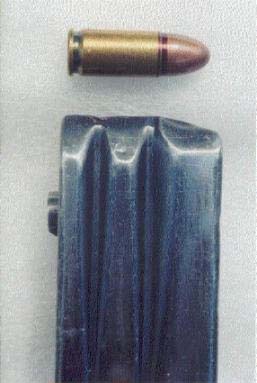
Photo C: Close-up of the Orita SMG magazine (right side). Note the button-like projection from the back edge of the magazine (at left), the unusual shape of the long feed lips and the deep cartridge guide ribs. A cylindrical 9x19mm cartridge can be seen above the top of the magazine.
The Romanian 9mm Orita Model 1941 SMG fires full and semi-automatic and the fire selector is located on the right side of the receiver. The fire selector has two positions: "up" for semi-automatic fire and "down" for full-automatic fire. A button safety in front of the trigger guard (see Drawing 1) can be pushed from side to side. Before to fire the weapon, the crossbolt safety must be pushed from right to left. If this safety is moved from left to right the weapon is safe and it cannot be fired. There is also a different variant of the Orita SMG which has a grip safety at the rear of the trigger guard (see Drawing 2). This type of safety may be found sometimes in various shapes (see Photo A1). This different variant of the Orita SMG has no fire selector and the weapon can fire only automatic fire. To fire the weapon the grip safety must be kept depressed. Pulling the trigger the weapon will fire. It seems that some Orita SMGs suffered modifications because their receivers are often stamped with marks like "Model 48" or "Modificat 48" (Modified 48).
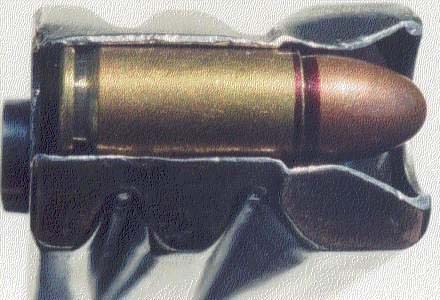
Photo D: Top view of the Orita SMG magazine loaded with one 9x19mm cartridge. The four deep cartridge guide ribs (two on each side of the magazine) stagger the rounds of ammunition loaded into the box magazine. Note the button-like projection from the back edge of the magazine (at left) and the large rounded cartridge guide cut out in the front edge of the magazine (at right).
Orita SMG is a magazine-fed weapon, a 32-round box magazine can be inserted vertically from below the receiver. The weapon has an excellent magazine housing which is well projected from the receiver wall. The shape of the magazine housing allows an easy and quick insertion of the box magazine and it serves as a forward grip for the shooter's hand. A box magazine must be inserted 65mm (2 9/16 inch) into the magazine housing to be locked right. A magazine catch-release is safely located on the rear of the magazine housing, making an accidental manipulation less possible. The weakest part of most SMGs is the exposed and vulnerable box magazine. If dented, damaged or too dirty to function, the box magazine may give feeding problems making the weapon useless. The Orita SMG magazine is strong and very well made and gives no feeding problems. It is a single-position feed magazine which accomodates a staggered double row of 9x19mm rimless cartridges. The spring-operated box magazine may be disassembled very fast (see Photo B). Compared with a two-position feed magazine, a single-position feed magazine (see Photo E) is usually harder to load but the Orita SMG box magazine can be fed with a little effort using no special tool. The box magazine used by Orita SMG has very long stiff and strong feed lips with an unusual shape (see Photo C & D). In the back edge of the magazine there is a rectangular bolt clearance cut out and beneath it a button-like projection can be noticed. This button-like projection (see Photo C & D) locks the box magazine inside of the magazine housing. At the magazine mouth in the front edge of the magazine, there is a large rounded cartridge guide cut out (see Photo D). Orita SMG magazine can be identified very easy because of the two long cartridge guide ribs indented into each side of the magazine body from top to bottom (see Photo B). These four ribs give more strength to the thick magazine body and at the same time reduce the internal friction. Deeply indented at the top of the blued magazine body, the four cartridge guide ribs (two on each side) arrange the loaded ammunition into a staggered column (see Photo C & D). The magazine follower is machined from solid steel and it is highly polished. It has an unusual shape (see Photo F) with a rib on its upper right side in order to arrange the rimless 9x19mm cartridges into a staggered column in the magazine. The front end of this rib has the shape of a curve to facilitate loading. The lower step of the machined follower is concaved for easier feeding (see Photo F). When the weapon is fired the spring-driven follower pushes upward the vertical staggered column of 9x19mm rimless cartridges (see Photo F) and the top cartridge from the box magazine is positioned in center for in-line feeding directly into the chamber. Orita SMG magazine uses a 24 by 25 turns conventional compression spring in elliptical shape. This spring does not fail when is fully compressed, it is strong enough to push correctly the last 9x19mm cartridge against the magazine feed lips and it is also not too strong, to allow easy loading of the box magazine. A depression is stamped into the back edge of the removable floorplate to help it to lock to the ribbed magazine body. The rear end of the floorplate is bent to a right angle to help to remove the stamped floorplate and to lock it back to the proper position. The steel bodied sheet metal Orita SMG box magazine is 232mm (9 1/8 inch) long and it weighs empty 255 grams (9 oz). A full loaded magazine with 31 rounds 9x19mm (the 32nd cartridge cannot be loaded) weighs 618 grams (21.8 oz).
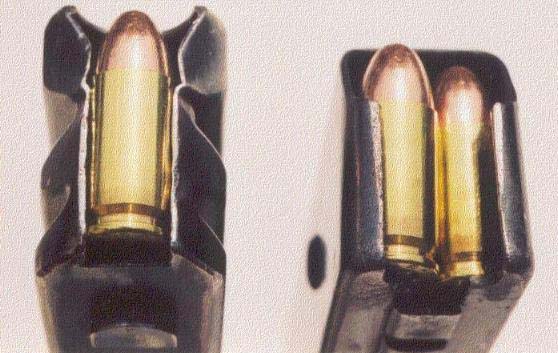
Photo E: At left: One-position feed arrangement of cartridges (Romanian Orita SMG 32-round box magazine); At right: Two-position feed arrangement of cartridges (World War II Italian Beretta SMG 40-round box magazine). Note: Both magazines accomodate inside a staggered double row of 9x19mm rimless cartridges.
The Romanian 9mm Orita Model 1941 SMG has a fixed solid wooden stock with a metal butt plate. The forestock extends up to the magazine housing. The shape of the long wooden stock differs slightly depending on the variant (see Photo A1). A long flat piece of wood with five parallel machined grooves is held by two screws on each side of the Orita SMG, the variant with the grip safety at the rear of the trigger guard (see Photo A1 & A). The wooden stock gives a better stability to the SMG than a folding metal stock, especially when the shooter fires the weapon for accuracy using semi-automatic fire. When aimed properly and used by a skilled shooter who fires semi-automatic fire, Orita SMG can give high marks. A 9mm bullet will always hit a normal-sized stationary silhouette target at 200 meters (220 yds). There are sling swivels mounted by the front end of the receiver and on the wooden stock, on the left or right side, depending on the variant. The weapon has the cocking handle located on the left side of the receiver which is machined from steel stock. This arrangement helps the shooter to change the box magazine and to retract the cocking handle with the left hand while the right hand can be kept near the trigger.
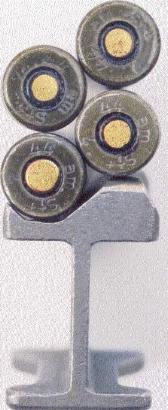
Photo F: Close-up of the rear side of the spring-driven follower used by the Orita SMG box magazine. Note the unusual shape of the follower (machined from solid steel) which presses upward a zigzag arrangement (staggered column) of 9x19mm rimless cartridges. This is the way the cartridges are positioned within any double-stacked magazine.
Like any other weapon, Orita SMG has to be disassembled into main parts for routine cleaning and maintenance. The procedure starts by pointing the barrel in a safe direction. After withdrawing the box magazine the chamber must be checked to be free of any cartridge. The receiver cap which is circular, closes the rear of the receiver and it differs slightly in length depending on the variant of the Orita SMG. The recoil spring with the bolt may be taken out from the receiver after removing the receiver cap. This operation must be done very carefully because the recoil spring is always compressed and under pressure inside of the receiver. The assembly procedure must be done exactly in the reverse order.
A reliable and powerful weapon which performed very good in harsh conditions, the 9mm Orita Model 1941 SMG passed the test of time. It was the standard SMG of the Romanian armed forces during World War II. The battle-tested Orita SMG proved to be a high quality robust construction weapon with long service life of all the parts and components. The total number of Orita SMGs manufactured by Romanians during World War II is unknown today but the production had to be intensive to equip the Romanian Army. A durable weapon, Orita SMG remained in army service more than a decade after the end of World War II. In mid-1970s Orita SMG was still used for training by the "Patriotic Guards", a kind of national guard and territorial defense that had been created in Romania after 1968. Later all the remaining Orita SMGs were replaced by Romanian made Kalashnikovs. This long service life has shown without any doubt the excellent quality of the Orita SMG, one of the world's finest SMG from World War II.
Nothing is perfect in this world and even an excellent design as Orita SMG has had a few drawbacks. The weapon was expensive and hard to manufacture because most of the parts had to be machined from solid pieces of metal. The quality has always required time and money. Orita SMG like most of the SMGs fires the standard 9x19mm pistol cartridge. At longer ranges the 9mm bullet has a limited penetrating and stopping power which decreases very fast. When fully loaded (with a loaded box magazine inserted in place and the bolt cocked), Orita SMG may fire accidentally if dropped or mishandled. A hard bump may also cause the weapon to go off. I know a story of a Romanian soldier armed with an Orita SMG who paid with his life for a moment of misjudgement. He hit the hard dry ground with the wooden stock butt of his SMG trying to kill a viper. Due to the violent impact of the blow the SMG fired, it had been fully loaded. Nobody knows what happened to the venomous snake but the imprudent young soldier was killed instantly.
Characteristic data:


The uniforms were designed by Hugo Boss under Hitler's direction, to make the soldiers look taller then normal. The jacket was cut short and the belt at the waist was high to give the impression that the soldiers were taller than they really were.
The uniforms were designed by Hugo Boss under Hitler's direction, to make the soldiers look taller then normal. The jacket was cut short and the belt at the waist was high to give the impression that the soldiers were taller than they really were.
Copyright: Osprey's "The German Army 1939-45 (1)" series.

